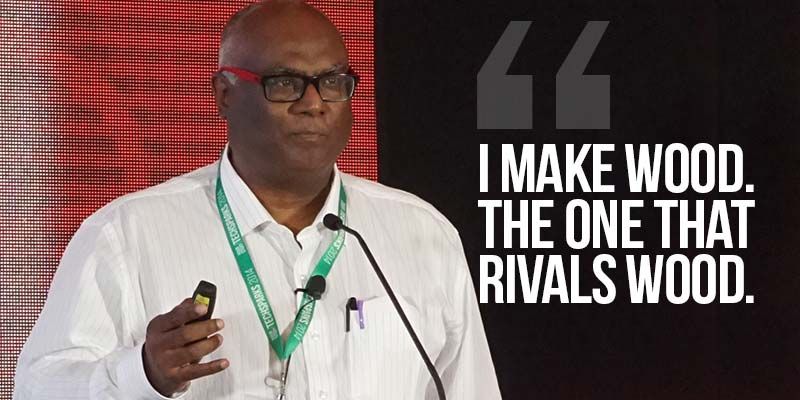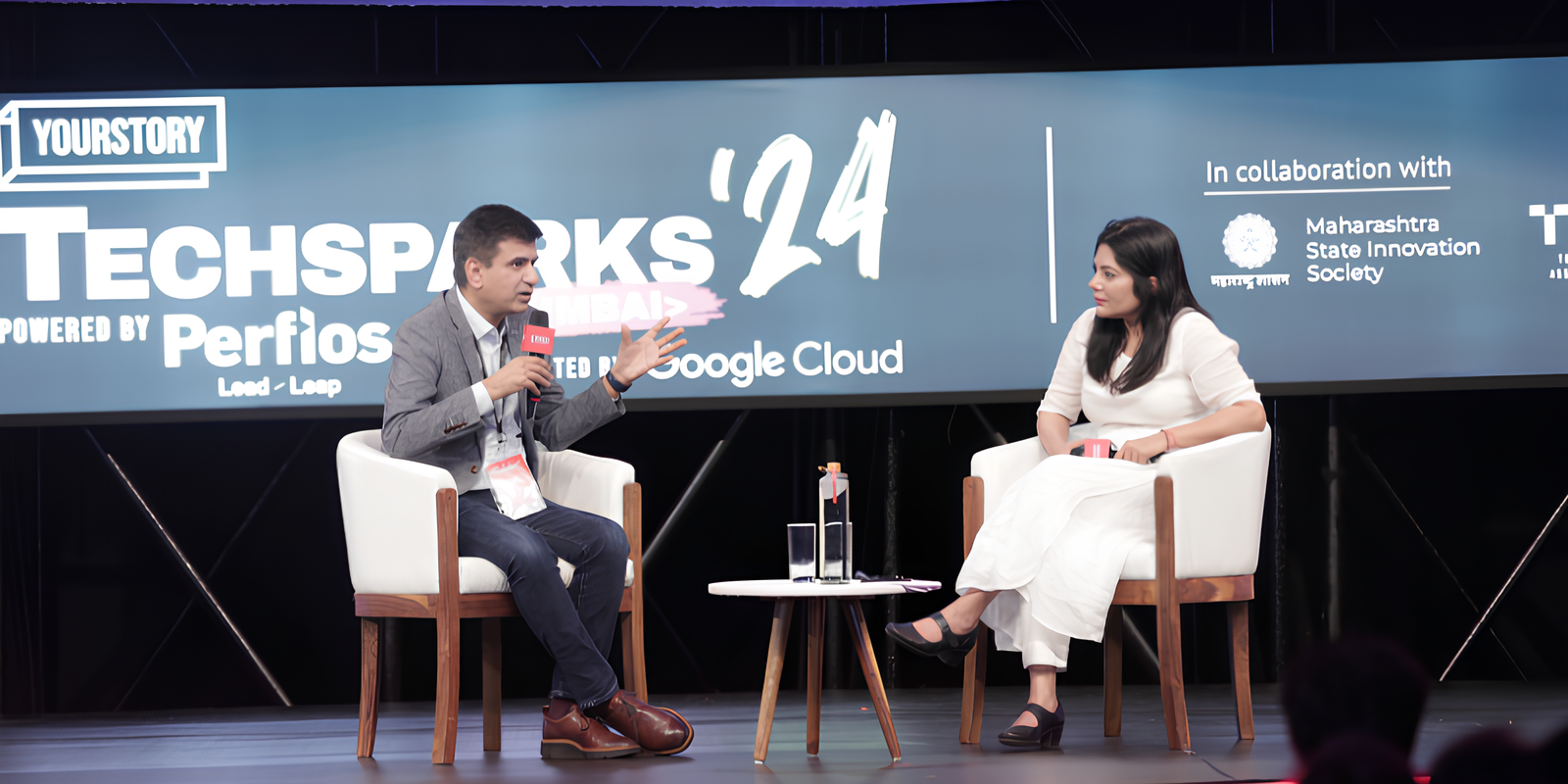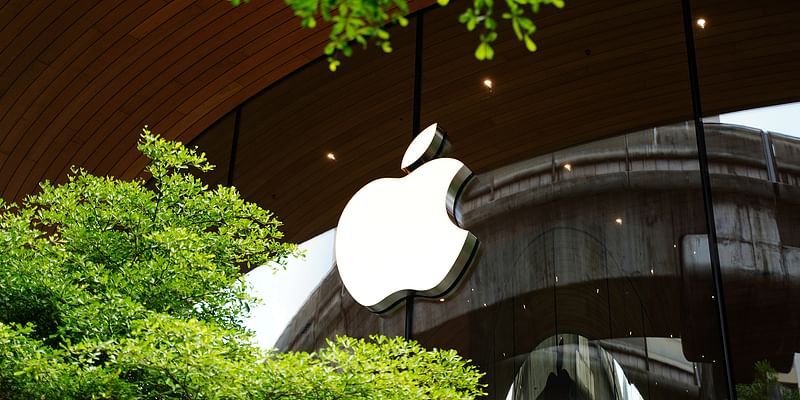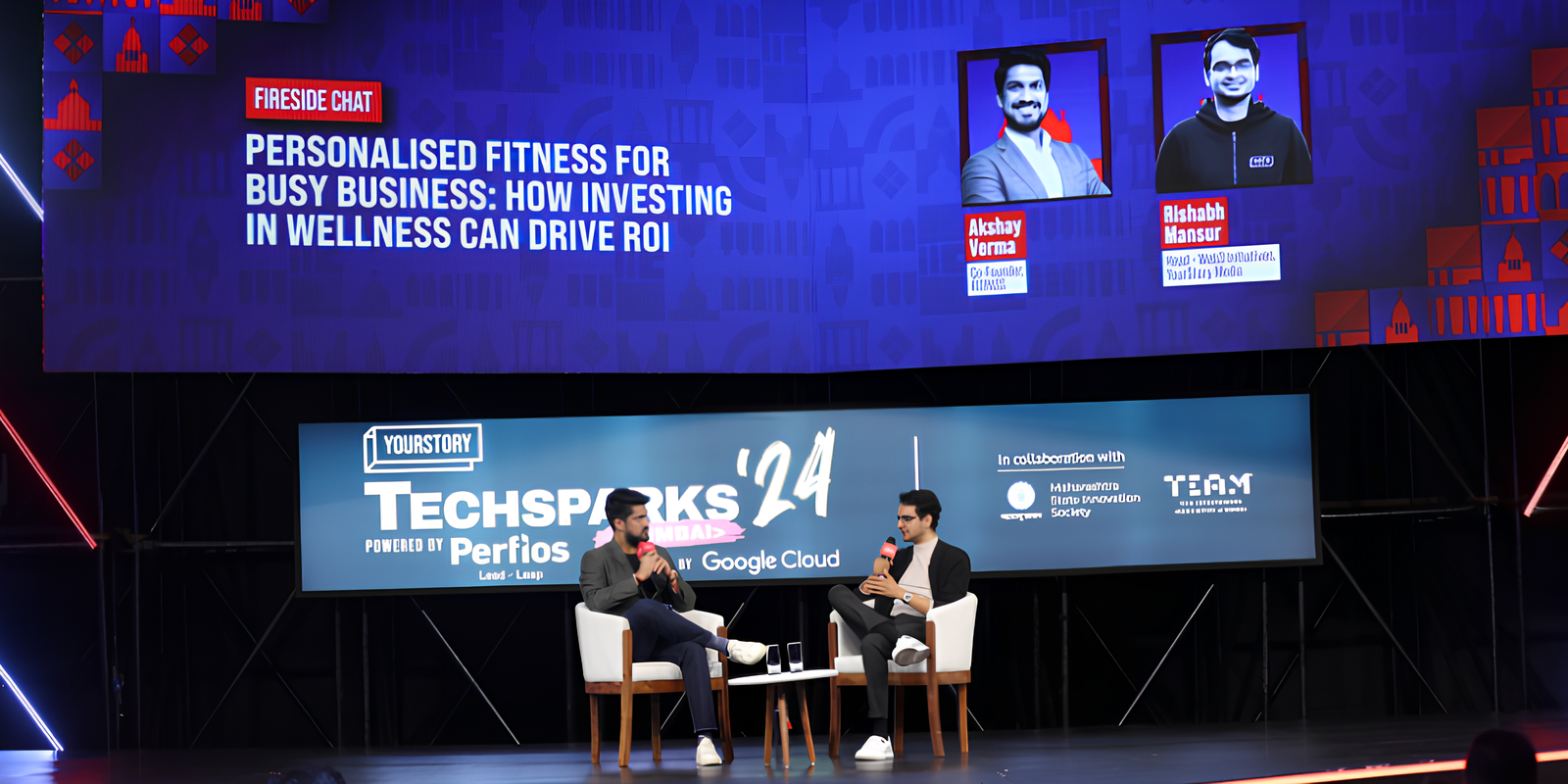How an ex-investment banker is making wood without cutting down trees and addressing the $150 billion market, the ChloroEarth story
And he said, “I make wood”. With that arresting statement, he continued intriguingly, “the one that rivals wood.”
David James, the 52-year-old Founder of ChloroEarth, an innovative company manufacturing a true analog of wood (bio-mimicry), knew exactly what he was saying at the Tech 30 showcase of TechSparks grand finale that concluded on October 18, 2014. It was not an easy task for him to summarize his 10 years of work in a 90 second pitch, but these daily challenges have been part and parcel of David’s life now.
He has created a company that lies in the confluence of material science, green chemistry, agronomy and Climate Change.

Did you know that?
a) It is a myth that the use of a tree in buildings and furniture is “green”. What pundits do not tell the lay man that once you harvest the tree the tree can no longer sequester the CO2 . Extrapolate this to millions of trees and one will realize the earth’s ecosystem is being severely assaulted.
b) The fact that agriculture sequesters a similar amount of CO2 has been overlooked as the renewable resource to address the issues of deforestation. A door made from hardwood has about 50 tons of carbon. Imagine if it was made from renewable agriculture residue!
ChloroEarth’s intent is to transform agricultural residue, waste and biological extracts as raw materials or inputs for industrial application. He terms this as introducing industrial ecology to the Indian farmer. His immediate application is the low hanging fruit that the world is seeking: alternates to wood and new materials for green buildings.
It will be unjust if the story of the struggle behind ChloroEarth remains untold. Here’s an attempt to run through the last decade of David’s life, the magician who makes wood, but not from trees.
The non-welcoming India of 2004
To address a family crisis, David returned to India after serving in Europe, Hong Kong, Singapore and the Far East for almost 14 years in investment banking and risk management sector. He hoped to do something for his country and the sustainable future of the world. To his surprise, the very hospitable India that he had left a decade and half ago didn’t offer him a warm welcome. Instead, he experienced discrimination because of his age and culture. His pride of being a well qualified professional was replaced by the tag of being ‘overqualified’ in India.
He said,
I discovered that business here had changed from the time I left the country. New India did not focus on problem solving, (what you know and solutions) rather they focused on who you know. In a society that relied on relationships and nepotism I was handicapped in my effort to fit back into India.
If this was not enough, he was beginning to lose his eye sight in 2005. From December 2007 till his eye surgery in October 2010, David’s left eye had deteriorated to become technically blind. He had partial eyesight in his right eye (severe Keratakonus). He recalls,
I had to take the help of family and friends, who accompanied me across India, while making presentations. No one knew I could not see my hand or computer screen in front of me.
Identifying the problem
During his stints as investment banker and as a consultant to tech and renewable energy companies, David had clearly understood that climate change is real and is causing a tectonic shift in how companies and workers need to adapt to climate change. At the same time, he noticed that the lack of risk mitigation tools and analysis around these drastic changes was causing un-meshing of the global economy and unraveling traditional supply chains across industries.
The capital that can intervene to fix or replace value chains was totally absent in India. David recalls,
There was a moment of epiphany when I saw a farmer yoked with his bull to plough his own field. And it prompted me to ask this question and arrive at what ChloroEarth is today: “Why does capital not flow to the impoverished farmer and/or the poor?”

The opportunity
David realized that the bankers and funders were un-building the real economy by not funding products and services that demanded ‘patient capital’. They seemed to find it sufficient to get a safe yield from a fixed asset rather than create new asset classes and grow the economy. He noticed that:
- There are new opportunities and over the horizon technologies that spring up from the threat of climate change that merit intervention capital. If Demand>Supply, such companies and technologies must be funded.
- The promotions into renewable projects under the Kyoto Protocol were only a tax arbitrage game in India.
- Unless companies describe their balance sheets by their net energy footprint, the global economy is going to go deeper into a tailspin.
Why agricultural waste
David arrived at utilizing the agricultural waste as the result of a process of discovery of defining what the problem was. It took him two years to get to the bottom of the solution.
Bio composites are supposed to be the answer to the depleting supply of forest products and mitigation to deforestation. But this category of business has stalled for 40 years or more.

It was well known that the lignin from agriculture was no different from the lignin from a tree, and in some cases even denser and better structured. Even though the technology was in place and had been tried out, bio-composites could not replace the use of hard wood. David says, “The world was clearly looking to go beyond bio-composites and looking for an alternative that could compete with the veneer or grain of a hardwood as well as the structural integrity it provides without the chemical toxicity the industry uses.”
ChloroEarth is a Global first to go beyond bio-composites and into bio-mimicry of wood.
Not only does ChloroEarth replicate the chemical signature and structural integrity of a wood panel of a natural tree but he allows the end product to create a unique grain with any artificial veneers to stand alongside a natural wood.
Of socio economic innovation
David says,
Truth be told, I was only interested in the technological solution initially. However, it dawned on me that if I cannot provide a socio economic innovation as part of my project, we would continue to treat rural farmers (the supply of raw materials) as third class citizen and leave them impoverished. I wanted to find a way to use technological breakthroughs backed by the demand for green products as a fulcrum to transfer wealth back to the farmer. In that way, I could co-opt the farmers as part of the production process, rather than continuing the adversarial buyer-seller relationships.
Here are a few things which helped David figure out the next step after bio-composite wood:
- Indian wood requirements theoretically can be met with the entire agriculture residue that is burnt or wasted.
- India produces the most amounts of bio-resins in the world due to her agrarian habits, but they lie un-monetized.
These two alone provide cost advantage that similar innovations in the West do not have. India has an unrivalled amount of raw materials at near zero cost. Both the above lie wasted today because of lack of recognition of its monetization potential. The fact that the entire adhesive (bio-polymer) requirements can be met and exported (massive IP with ChloroEarth) with 90% of her bio resins is an open secret.
The innovation: ChloroEarth’s version of carbon fiber

ChloroEarth is the first company to cross the Rubicon from bio-composites to bio-mimicry.
Starting from weather derivatives and ways to mitigate climate change on commodity companies in Indonesia, to actually identifying renewable building materials from agriculture renewable resources, ChloroEarth has identified specific ‘Sorghum Strains’ with a lignin content that can compete with teak.
Through a unique matting process it creates its own veneer (signature non structural applications like cladding). The company’s breakthroughs in bamboo are building a true ‘green structured board’ that can be classified as the Third World’s answer or a poor man’s carbon fiber for certain structural applications. One of the first companies in the world to fuse silica in agri-fibers with bio-polymers, ChloroEarth provides unrivalled structural characteristics.
This is the green chemistry or the secret sauce of ChloroEarth’s solution.
ChloroEarth engineered wood boards are an evolutionary leap from ‘bio-composite boards’ which are made from the agricultural waste/residue and use bio-resins to produce “green” building materials. They have their own “grain” that can distinguish it and also be contrasted to other wood grains. They also have the characteristics of conventional wood based panels unlike the bio-composite boards which are softer and weaker.
David states with confidence,
The company is very strong by its uniqueness. We have no intention of filing patents but will keep the core parts of green chemistry and engineering proprietary.
ChloroEarth is also considering providing consulting options in geo-polymer know-how to replace OPC and steel at 20% of today’s cost.

The numbers gameTill date, ChloroEarth is funded by David himself and by his partners (Technical Pilots etc in time, tech and labour). Together they have invested around $200-250K.
The company is catering to the $150 billion market which majorly comprises of the $25 billion in wood panels, $50 billion in housing and $60 billion in bio-polymers.
People behind ChloroEarth
David James is the CEO and the one who connects the dots at ChloroEarth. He was the first to identify the problem of a poor image that bio-composites have, as well as the impact of integrating climate change solutions with agronomic solutions to provide farmers with a “second harvest”.
He expresses deep appreciation with humility and honour of working with two of the stalwarts of the Industry. Late Dr. Joseph George, the pioneer of bio-polymers and wood technology and agri-fiber since 1945. The granddaddy of wood and biopolymer research was an integral part of the company till his death in 2012. He is assisted by Shantala Srimallu.
Ramakrishna Viswanathan, the trailblazer of wood machines and global innovator and advisor to governments worldwide, has been a technical advisor and mentor since the early days. Bharat Parashar is the CMD of Clove Partnerships and mentor on Cross Border risk and structuring..Bong Layung of Budji, the 7 star Interior and Housing designer in Asia, advices on marketing. Bharat, Bong and David are alumni of The Asian Institute of Management.
University of Dharward has contributed a lot in this path-breaking research and in developing an innovative procurement programme with farmers by running off-take pilots.
Challenges in running ChloroEarth today
1) The IP can be continuously captured in a smaller vehicle with smaller production from the results of the pilots and dry runs already done. By doing this in this way, David intends to scale down original production volumes and to bring down the capex. He intends to develop a hybrid pilot and a micro production for sorghum boards.
2) Shift the original capital to the ready-to-upgrade-and-run dormant factories in NE as offtake agreements. They already have Techno Demonstration plant for bamboo that was renovated for new partners in the north-east to manage cash flow and move the project along. They have redesigned an existing ply wood plant integrating the proprietary technology at a fraction of the cost to fire up in 30 days. They need to renew the land lease and refurbish a particular machine.
3) Raise cash for scaling ChloroEarth and the back end engineering units.
Social and environmental Impact

The larger focus of ChloroEarth has always been on addressing the socio-economic problems and to create an impact. David says, “My focus is on 60% of India’s population that lives in the rural areas and is dependent on subsistence farming. One cannot ignore the high rate of farmer suicides as they struggle to make ends meet under crippling debt. Our solution goes towards raising awareness of this problem and provides an alternative active farming model to mitigate this problem.”The environmental and climate change concerns that ChloroEarth is addressing and engaged in building new materials from sustainable resources, can replace high energy/carbon products in buildings.
That is why David named his startup ChloroEarth™ - ReBuilding with Nature©
Ellen Petry Leanse, the guest of honor at TechSparks, described David’s work as:
ChloroEarth has not only created a new category of business but may have created a new industry altogether as the ideas and tech would benefit all of mankind. He has positioned and redefined the problem in an entirely new light. Indeed, David’s ChloroEarth is not merely the answer, he is the question.
If there was no ChloroEarth
On being asked what would he be if not the founder of ChloroEarth? David simply states,
I would love to provide mentor capital as well managing finance within a fund manager to green companies. I would also help in bringing ‘over the horizon’ technologies to market. For example, building new cities threatened by rising water levels in low lying countries like Bangladesh, and Philippines etc. because of which 200 million people are at risk of loss of habitat in 15 years.











